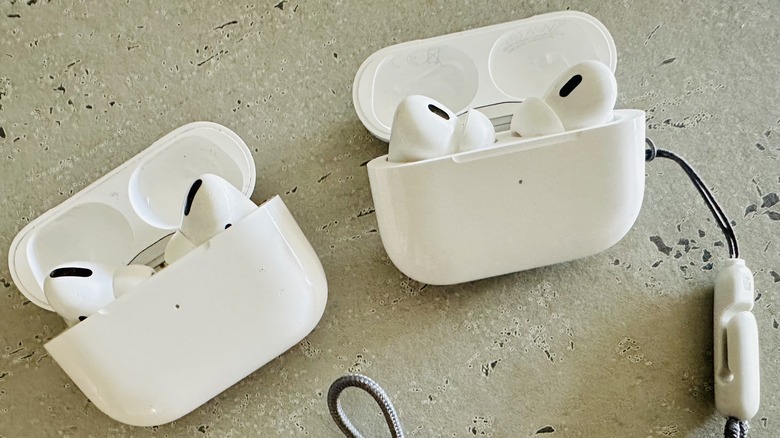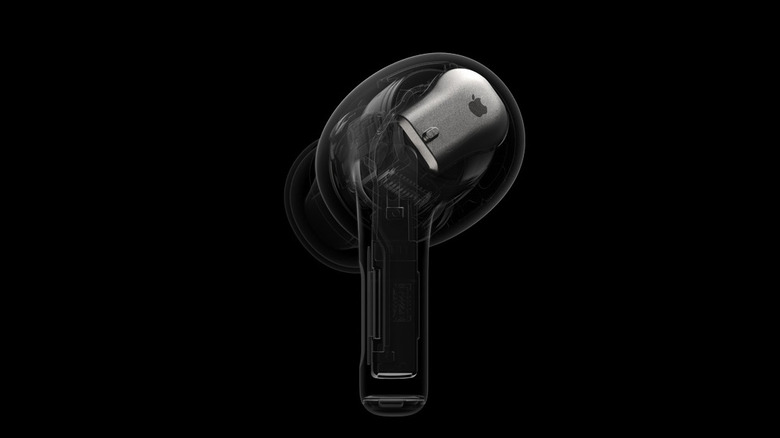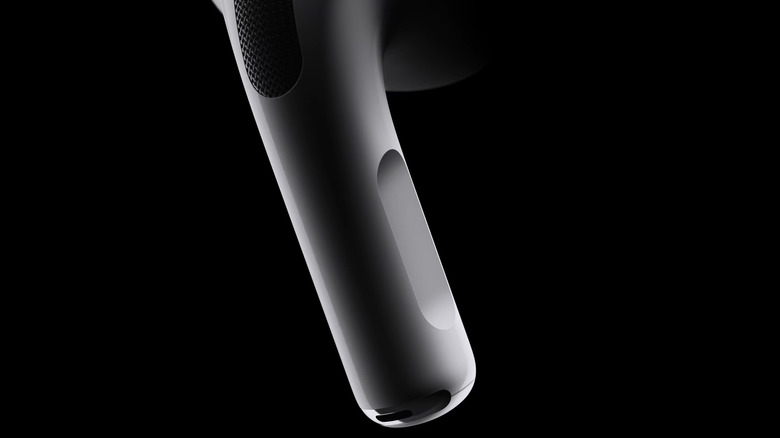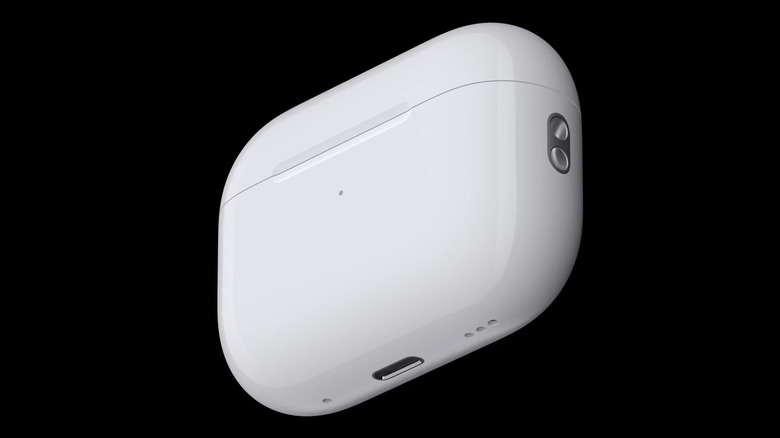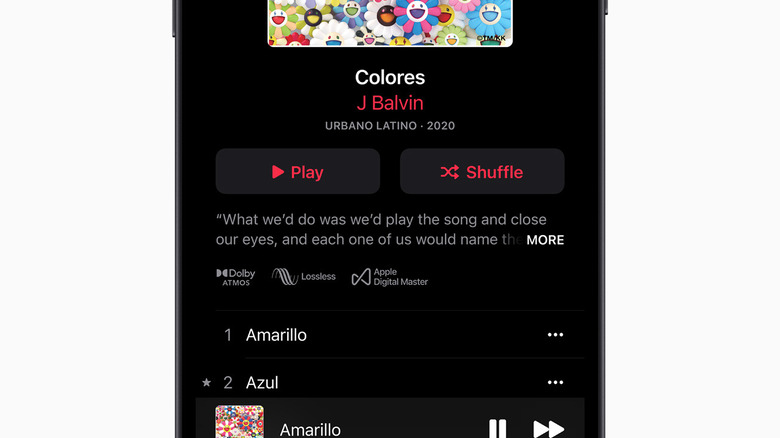The Major Differences Between AirPods Pro 2 Vs AirPods Pro Explained
The first AirPods arrived with the launch of the iPhone 7, which was the first iPhone to controversially drop the headphone jack all the way back in 2016. Of course, since then, many phone makers have dropped the venerable and once ubiquitous 3.5mm jack, too. A good part of the reason for this is how Apple popularized true wireless (TWS) earbuds thanks to a combination of relatively good audio quality over Bluetooth and ease of use.
In 2019, Apple stepped up the audio quality of its AirPods with the launch of the AirPods Pro, which also featured the addition of active noise cancellation, a transparency mode, sweat and water resistance, and an adaptive EQ powered by the custom Apple H1 chip. (Spatial audio became an additional feature when Dolby Atmos audio was launched on Apple Music in June 2021). The AirPods Pro were met with positive reviews and, like the original AirPods, have been strong sellers for the company — Although there was a bit of a hiccup when Apple was forced to launch a service program for models made before October 2020 that were prone to audio glitches.
Sound improvements
The rise of Apple's AirPods has created a massive multibillion-dollar market for TWS earphones (and over-ear and on-ear headphones that compete with the likes of Apple's critically acclaimed, but expensive, AirPods Max). The field of competitors is large and Apple has responded by looking to raise the bar with the sound quality of the AirPods Pro 2 (officially known as AirPods Pro, second-generation). While they look almost identical to the original model, Apple has given the internals a thorough working over. This includes a new low-distortion driver and custom amplifier powered by Apple's new H2 chip that further enhances the adaptive EQ feature found on the original AirPods Pro with faster adaptation algorithms to precision-tune the listening experience to the listener's ears in real-time.
Apple says the H2 chip combined with noise-canceling mics and rear vents helps to deliver noise cancellation that is twice as effective, reducing noise at 48,000 times per second. The H2 chip also helps to power a new Adaptive Transparency mode that intelligently blocks out sounds that exceed music listening levels, and it is turned on by default but can be deactivated or reactivated with a long press on the stem controls. Apple has also introduced a new personalized spatial audio feature in conjunction with the TrueDepth Camera system on a user's iPhone. This provides a scan of a user's ear geometry for a purportedly more customized listening experience.
Other design changes
One aspect of the AirPods Pro 2 design that has changed subtly is a new, slightly flattened touch-control surface on each stem. Either side will deliver the same functions based on input — A single touch will pause or play a track, a double touch will skip a track and a triple touch will skip back a track, while holding either bud with your thumb while sliding a finger up or down the stem increases or decreases the volume. Where the original AirPods Pro used an optical IR sensor for in-ear detection, the new AirPods Pro 2 switches to skin-detecting sensors. Apple has also been kind enough to add a new extra-small (XS) ear tip, taking the total number of tips available for a tailored fit up to four. Apple seems to be responding here to complaints that the original AirPods were an uncomfortable fit for some users.
Battery life gains and a case overhaul, too
As you might expect with the release of a device that depends heavily on being battery-powered, Apple has increased the battery life of the AirPods Pro 2 by up to 1.5 hours, taking the listening time up to 6 hours from 4.5 hours with active noise-canceling enabled. Similarly, Apple has also increased the total available listening time when using the new case, taking it from 24 hours right up to 30 hours when on the go.
Speaking of the new AirPods Pro 2 case, Apple has increased its capabilities with some cool new tricks. It now includes a small built-in speaker that chimes when out on a charger, while it will also emit a signal when "Find My" is used to locate it. Also making it even easier to find is a new precision location function. The new case is also able to charge wirelessly over an Apple Watch charger, whereas the original AirPods Pro could only charge via a Qi-enabled mat or MagSafe charger. Apple has also endowed the AirPods Pro 2 case with the same IPX4 sweat and water resistance as the AirPods Pro 2 themselves, while Apple's designers even added a new lanyard loophole in the case, which is another very handy addition.
What hasn't changed?
When Apple introduced lossless (16-bit CD-quality) and hi-res audio (24-bit), along with spatial audio, on Apple Music back in 2021, it came as something of a surprise to some that none of Apple's AirPods supported lossless playback. This includes Apple's pricey AirPods Max, even when connected over a wired connection. While it later added support for wireless lossless audio for its HomePod line, the lack of lossless support for its AirPods was notable. One of the rumored feature upgrades for the AirPods Pro 2 was the addition of lossless audio support over Bluetooth, but that did not eventuate.
Although Bluetooth has limited bandwidth, hi-bitrate codecs such as Sony's LDAC and Qualcomm's aptX HD delivered arguably a higher quality of transmission at up to 900 kbps. Conversely, Apple continues to rely on the sub-CD-quality AAC codec, which is limited to lossy audio files encoded at 256 kbps. While this is considered good enough for most people, newer Bluetooth standards have been launched in the past twelve months that claim to support lossless transmission over Bluetooth. This includes the new aptX Lossless codec and the just-launched Samsung Seamless Codec (SSC), which the Korean company claims audio playback over Bluetooth right up to 24-bit hi-res, as supported on its new Buds2 Pro. If Apple is developing its own in-house solution, it could be that it will launch it with the anticipated AirPods Max refresh, now that Apple has completed its update cycle for its entry-level and mid-tier AirPods.
